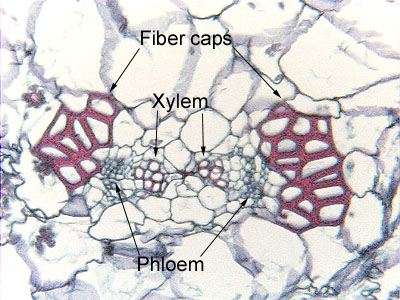 Fig.
11.3-8. Transverse section of cactus stem (Lepismium
cruciforme; no common name). This
is an epiphytic cactus and it grows only in wet habitats: hanging
from the branches of large trees in rainforests. It
too has cortical bundles, but these are unusual because they have primary phloem
fiber caps. And the caps are much larger than the rest of the
cortical bundle. It may be that these cortical bundle fibers help strengthen the
dangling stems – the stems can be about a meter long, and must resist the
flexing and bending caused by wind.
Fig.
11.3-8. Transverse section of cactus stem (Lepismium
cruciforme; no common name). This
is an epiphytic cactus and it grows only in wet habitats: hanging
from the branches of large trees in rainforests. It
too has cortical bundles, but these are unusual because they have primary phloem
fiber caps. And the caps are much larger than the rest of the
cortical bundle. It may be that these cortical bundle fibers help strengthen the
dangling stems – the stems can be about a meter long, and must resist the
flexing and bending caused by wind.
In this section, two cortical bundles are running parallel to each other, which is not very common.